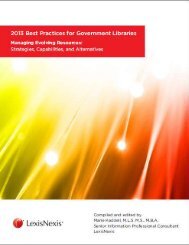2012 Best Practices for Government Libraries
2012 Best Practices for Government Libraries
2012 Best Practices for Government Libraries
You also want an ePaper? Increase the reach of your titles
YUMPU automatically turns print PDFs into web optimized ePapers that Google loves.
Records Management <strong>for</strong> the Librarian: Part One<br />
243<br />
BEST PRACTICES <strong>2012</strong><br />
By Ellen Ensel, Knowledge Manager, In<strong>for</strong>mation Services, United States Institute of<br />
Peace<br />
In which a Knowledge Manager with an MLS learns a thing or two about the field of<br />
Records Management.<br />
I’m a Knowledge Manager with responsibilities <strong>for</strong> knowledge management, library<br />
services and records management at my organization. I’ve been juggling the first<br />
two <strong>for</strong> some years now, but records management is a new assignment <strong>for</strong> me. It<br />
coincides with the departure of our Director of Administration who handled this area<br />
previously (mostly by keeping everything) and the Presidential memorandum of<br />
November 28, 2011, calling <strong>for</strong> better records management across all federal<br />
agencies.<br />
I had no training in records management, of course, but now I was responsible <strong>for</strong><br />
developing a records management program <strong>for</strong> my organization. Which brings me<br />
to my attendance in a class at the National Archives and Records Administration<br />
(NARA) in College Park, MD. I’ve just completed the first of five courses to receive<br />
NARA’s Certificate of Federal Records Management Training.<br />
Knowledge Area 2: Creating and Maintaining Agency Business In<strong>for</strong>mation<br />
(KA1 is an Overview and not part of the Certificate Program), is a two-day course<br />
devoted to helping us understand what federal records are (almost anything<br />
created or received by an agency in the course of business), who is responsible <strong>for</strong><br />
various levels of managing records (almost everyone), how to plan and execute a<br />
records inventory (tougher than it looks), and elements of, and tools <strong>for</strong>, managing<br />
and organizing in<strong>for</strong>mation. The course included instructional material, group<br />
activities and some sample handouts.<br />
One amusing exercise called “Watch Your Lingo” directed us to look at different<br />
definitions <strong>for</strong> the same word (archive, file, etc.) coming from the records<br />
management or IT perspective. The same could be said about library science or<br />
knowledge management. Although most of the people in my class were already<br />
involved in records management in some way at their respective agencies as<br />
Records Liaisons or Records Officers, the language and topics of the course should<br />
be familiar to those of us with library science backgrounds and experience in<br />
knowledge management. For example:<br />
Understanding the business processes of an organization (knowledge<br />
management)<br />
Applying metadata to records (cataloging)<br />
Conducting a records inventory (inventory of print or electronic collections)<br />
Disposition of records (weeding or de-accessioning)<br />
Understanding the limitations of electronic media and the need to migrate<br />
data to new <strong>for</strong>mats (digital collections)<br />
Electronic in<strong>for</strong>mation systems (online catalogs)



